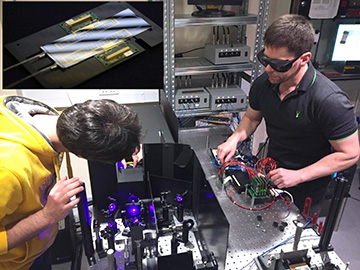Anthony Laing of the University of Bristol (right) in the lab with Ph.D. student and coauthor Nicola Maraviglia (left). Inset shows a close-up of the photonic chip used to perform simulations of molecular dynamics. [Image: University of Bristol/inset photo by Nobuyuki Matsuda, NTT] [Enlarge image]
Modeling how molecules vibrate requires massive computational power. Now, an international team led by researchers at the University of Bristol, U.K., has demonstrated a quantum approach that uses a photonic chip to simulate molecular dynamics and provide frame-by-frame virtual movies of the atomic motions (Nature, doi: 10.1038/s41586-018-0152-9). The development could, the researchers suggest, spark new, more efficient molecular modeling methods helpful in the creation of new pharmaceutical chemicals and other substances.
Quantum advantage
Quantum computers will be significantly faster than current supercomputers at solving certain types of problems, making them an obvious choice for computationally intensive tasks like modeling molecular motion. Building on previous work in the use of optical chips as building blocks for quantum-computing circuitry, the Bristol researchers, in collaboration with scientists at Imperial College London, Nokia Bell Labs, the Massachusetts Institute of Technology, Indiana University Purdue University and the Japanese telecom company NTT, applied integrated quantum photonic technology to develop a simulator for molecular quantum dynamics.
The chip-based simulator exploits analogies between vibrational modes in molecules and optical modes in waveguides, and between quantized vibrational excitations and single photons. The chip itself consists of an array of single-mode waveguides, with beam splitters, phase shifters and directional couplers that can be configured to implement a unitary transfer matrix. Performed over a series of time steps, this simulates a desired Hamiltonian on a molecule’s initial multimode vibrational state by mapping it to a corresponding multimode optical input states.
Using spontaneous parametric down-conversion sources, the team generated various single-photon input combinations for the simulator, representing molecules with different initial multimode vibrational states. The subsequent number and pattern of photons detected at the output (using single-photon counting modules) at each time step, for each specific circuit configuration of the chip, indicate the probability the molecule will be in a particular vibrational state at a particular time. The readout at each time step is like a frame in a movie.
Play, pause, rewind
The chip components are easy to reconfigure, making it very versatile. Chris Sparrow, who worked on the project at Bristol as part of his Ph.D., said in a press release accompanying the work that the platform “can be reprogrammed in just a few seconds to simulate different molecules.”
The authors began by simulating the time evolution of vibrational excitations in the harmonic approximation for several four-atom molecules, including ammonia and formaldehyde, before moving on to study more complex molecules. They studied a water molecule as it reaches thermal equilibrium with its environment, and energy transport in a protein fragment.
Sparrow, who is also joint first author of the article, explained that because time is a controllable parameter in the simulation, the team can manipulate it to examine particular vibrational patterns in detail, jumping to a point of interest, playing the “movie” in slow motion, or even rewinding it.
Toward a practical platform
A convenient modeling method like this one, that uses programmable linear optical circuitry to provide greater understanding of molecules as they vibrate at the quantum level, will, according to the researchers, be critical for future efforts to control molecular behavior. This type of quantum simulation also offers one early application for photonic quantum technology that goes beyond the classical limits.
Project leader Anthony Laing noted in a press release, though, that scaling up the simulators to a point where they offer practical advantages relative to classical computing “will likely require error correction or error mitigation techniques.” Another goal, he says, will be to “increase the sophistication of the molecular model” used to program the simulator.
“Part of this study was to demonstrate techniques that go beyond the standard harmonic approximation of molecular dynamics,” Laing said. “We need to push these methods to increase the real-world accuracy of our models”—and, hence, their applicability in pharmaceutical design and industrial chemistry.

